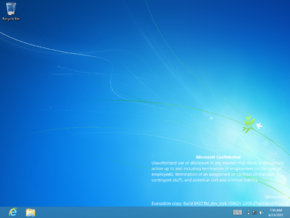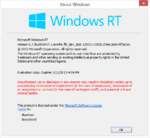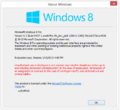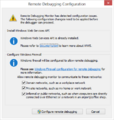Windows 8 build 8437.1 (fbl_dev_dp8)
| Build of Windows 8 | |
 | |
| Release name | Developer Preview 8 |
|---|---|
| OS family | Windows NT |
| Version number | 6.2 |
| Build number | 8437 |
| Build revision | 1 |
| Architecture | ARM32, x64 |
| Build lab | fbl_dev_dp8 |
| Compiled on | 2012-06-21 |
| Expiration date | |
| Timebomb | 2013-01-15 (+208 days) |
| About dialog | |
Windows 8 build 8437.1 (fbl_dev_dp8) is the official Developer Preview 8 build of Windows 8. Several images of this build running on a Qualcomm Snapdragon S4 (APQ8060A) Mobile Test Platform were first shared online on 9 August 2023; the full build was later shared in the form of a WIM image dump by Chinese website BetaWorld on 21 August 2023.[1] The x64 version was shared on 27 October 2024.
This build uses production code signing and can be booted on the current date.
ARMv7 compile installation[edit | edit source]
QEMU installation guide:
Prerequisites[edit | edit source]
The following requirements used in order to install this build onto a virtual machine are listed below:
- A copy of QEMU v6.2.0, modified for Windows RT compatibility
- A version of the firmware designed for ARM32 emulation (https://github.com/pivotman319-owo/woahefi-nt6x/releases/tag/r0.01), to be placed in the QEMU installation directory under
fw/QEMU_EFI_woahefi.fd - One virtual hard disk image (for storing the operating system)
Precautions[edit | edit source]
- Certain Windows 8 builds (such as 8330 (fbl_woa) or 8422 (fbl_woa)) may fail to properly load certain binaries on most startup attempts due to an emulation bug that causes the boot environment to read files incorrectly (especially the Hardware Abstraction Layer) causing an invalid checksum error, despite the files themselves being unmodified. This can be worked around by attempting to retry the startup attempt multiple times.
- USB emulation is largely unstable and may result in all input devices failing to register any user inputs. To restore input, switch to the QEMU compatibility monitor (Ctrl+Alt+2) and run the following commands:
device_del kbd device_add usb-kbd,id=kbd device_del mice device_add usb-tablet,id=mice
- Multiple BSODs might cause "Preparing Automatic Repair" messages, an early boot error will appear afterwards.
- Currently, builds within the 85xx-9200 range cannot be booted on QEMU because the Hardware Abstraction Layer (HAL) implementation in these builds is not compatible with the current state of the emulated ARM system. This can be resolved by replacing
hal.dllwith the one in 8439 and disabling Driver Signing Enforcement (DSE).
Instructions[edit | edit source]
Create the needed virtual disk image through the diskpart utility by running the below script; they will be created under a directory in the C: drive named ARM8. The partitions it will contain will be respectively mounted under drive letters F and P.
create vdisk file="C:\ARM8\HDD.vhd" maximum=65536 type=expandable select vdisk file="C:\ARM8\HDD.vhd" attach vdisk convert gpt create partition efi size=100 format quick fs=fat32 assign letter=F create partition primary format quick fs=ntfs assign letter=P exit
Deploy the image and apply the generic product key from the build's installation media by invoking the following DISM commands, then add the boot files to the EFI partition:
DISM /Apply-Image /ImageFile:"X:\path\to\install.wim" /ApplyDir:P:\ /Index:1 DISM /Image:P:\ /Set-ProductKey:NFV72-RG2HG-7FTTP-8FJTB-FF848 /AcceptEula bcdboot "P:\Windows" /s F: /f UEFI
Eject the currently attached virtual disk from the machine, then paste and run the contents of the below script onto a batch file within the QEMU installation directory, replacing YYYY-MM-DD with a date which is prior to the build’s built-in timebomb expires.
set MAIN="C:\ARM8\HDD.vhd"
qemu-system-arm ^
-M virt,force_el3=true,force_psci=true,pci=false,highmem=false ^
-cpu cortex-a15 -smp cores=4,threads=2 -m 2048 ^
-device usb-kbd,id=kbd -device usb-tablet,id=mice ^
-drive id=SD,if=none,file=%MAIN% -device sd-card,drive=SD ^
-bios fw\QEMU_EFI_woahefi.fd -device VGA ^
-rtc base=YYYY-MM-DD,clock=vm ^
--accel tcg,thread=multi
Continue installing the operating system through normal means.
Editions and keys[edit | edit source]
| Edition / SKU Name | Key |
|---|---|
| RT (CoreARM) | BN4FD-28M77-4VJMY-C9R68-XWW48 |
| Professional | GCNRF-BHBCM-W9YWM-VWQP6-TJBWR |
| ProfessionalWMC (edition upgrade only) | JGN88-JG6P9-XWD9R-3VX46-9KTF7 |
Changes[edit | edit source]
Desktop Gadget Gallery removal[edit | edit source]
The Desktop Gadget Gallery was removed from the operating system due to remote-code execution vulnerabilities which were disclosed in a security advisory weeks later on 10 July 2012,[2] additionally complimented by a package that respectively disabled the Windows Sidebar and Desktop Gadget Gallery functionalities on Windows Vista and Windows 7.[2]
Miscellaneous[edit | edit source]
- The Windows Store application received its final icon design.
- The previous Windows logo on the ⊞ Win key in the On-Screen Keyboard has been replaced by the new one.
Bugs and quirks[edit | edit source]
- Elements in the Windows Easy Transfer migration application do not size correctly.
Built-in development tools[edit | edit source]
This build's ARM32 image dump includes a set of development tools primarily targeted towards Qualcomm hardware and driver development. In particular, the Windows\Setup\scripts directory includes the following customizations and additions for the operating system:
- Scripts for provisioning the associated device that the build originated from
- Internal Qualcomm documentation for Secure Boot enablement, along with an early Secure Boot Debug Policy dated 16 May 2012 and a debug policy installer application from build
6.2.8432.0 (winmain.120611-1243) - The Windows App Certification Kit from its earlier
winmaincompile - Remote Tools for Visual Studio 2012, build 11.0.50623.2
- Windows Device Console from build
6.2.8522.0 (win8_rtm.120721-1642) - Original WinJS AppX dependency packages from build 8377, and the AT&T Communications Manager (presumably required for mobile operator testing)
- Windows PowerShell commandlets for
Add-AppDevPackage
- Windows PowerShell commandlets for
- Firmware for the Sierra Wireless AirPrime MC7700 modem, version 03.05.12.04
- NVIDIA Tegra 3 Cardhu Reference Platform-related specifics which were unintentionally included as part of the image; relies on the presence of a
nvidia.txttext document in the script folder root to install- Icera modem firmware (revision 3.00_9.2) and factory testing utilities
- Board power configuration
- The respective Camera and Reader applications from builds 8514 and 8513 (win8_rtm)
Gallery[edit | edit source]
x64 compile[edit | edit source]
Interface[edit | edit source]
ARM32 compile[edit | edit source]
Interface[edit | edit source]
Desktop with
winverand Registry Editor
Built-in development tools[edit | edit source]
Images published prior to upload[edit | edit source]
Test Platform photographs[edit | edit source]
System Properties Control Panel subpage
Interface[edit | edit source]
Desktop with
winver
References[edit | edit source]
- ↑ https://blog.betaworld.cn/archives/122
- ↑ Jump up to: 2.0 2.1 Microsoft. Vulnerabilities in Gadgets Could Allow Remote Code Execution (Microsoft Security Advisory 2719662), Microsoft Security Response Center. 10 July 2012.























